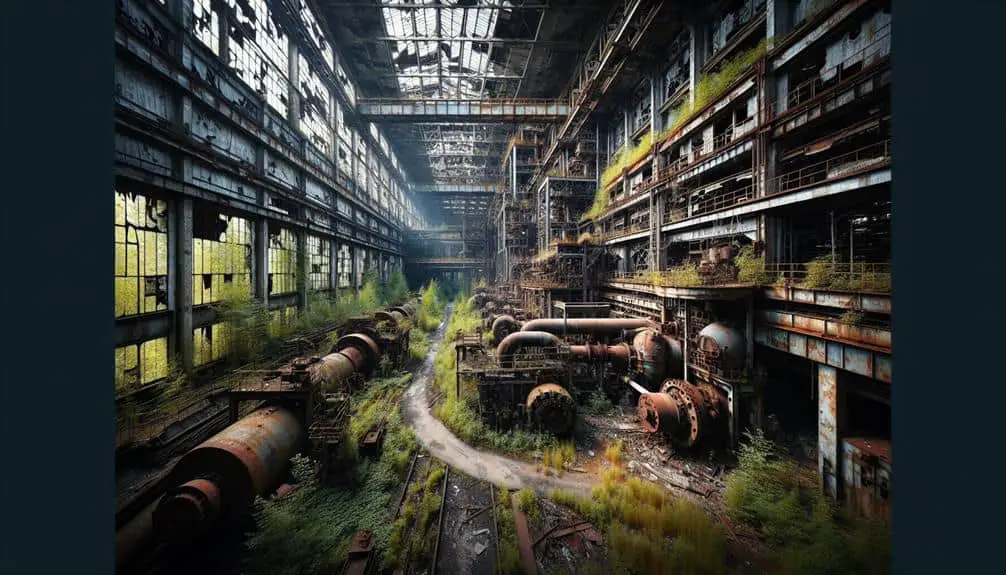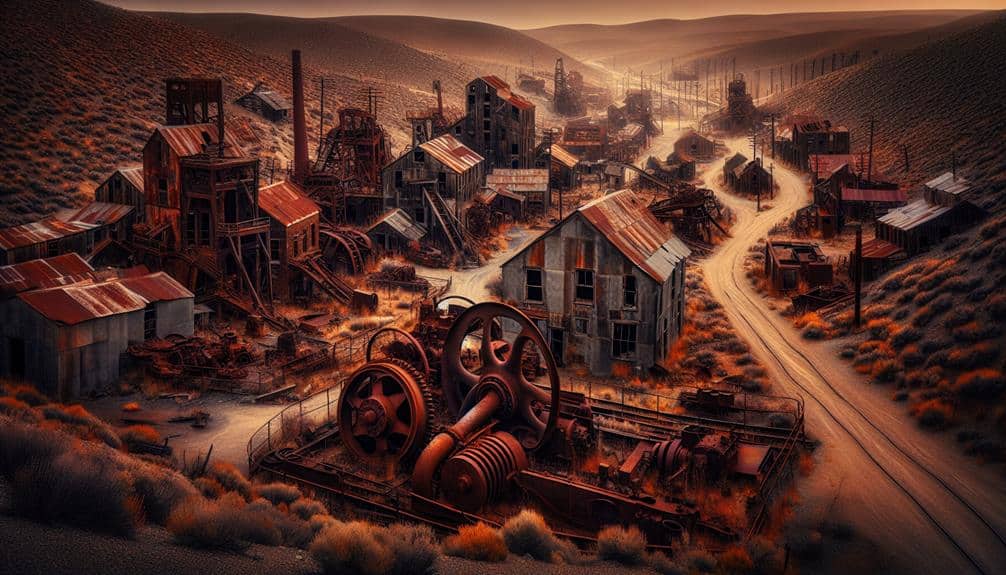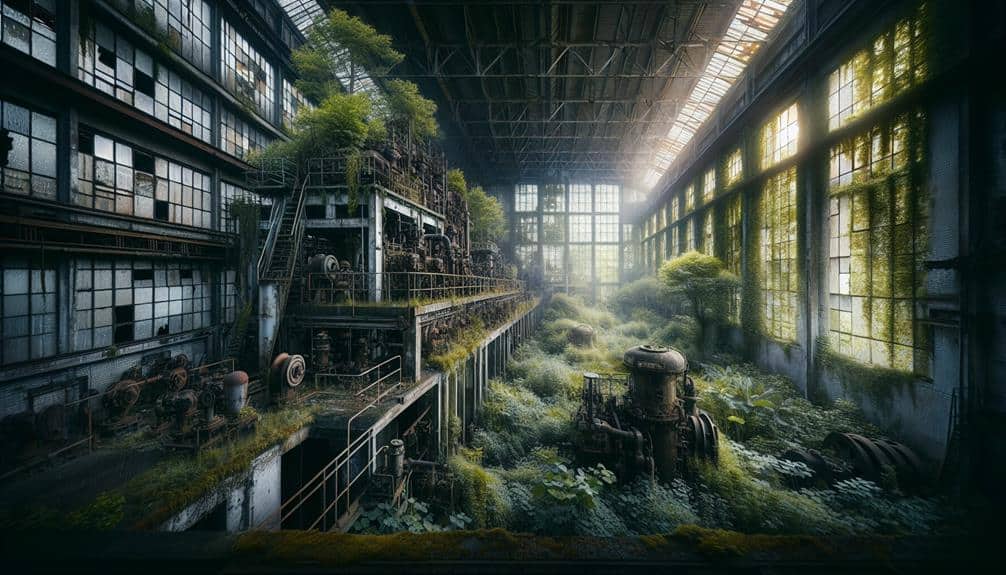Economic shifts from globalization and fierce competition decreased demand for local products. Automation in industries displaced the workforce, reducing job opportunities. Environmental factors like climate change and resource depletion strained industrial activities. Transportation changes marginalized industrial ghost towns. Population shifts towards urban areas altered the social fabric. These factors combined to reshape the landscapes, economies, and communities of industrial ghost towns. Understanding these dynamics provides insight into the fate of these once-thriving areas.
Key Points
- Globalization led to overseas competition and reduced demand for local products.
- Automation displaced the workforce and decreased employment opportunities in industrial towns.
- Environmental factors like climate change and resource depletion increased production costs.
- Changes in transportation infrastructure marginalized industrial ghost towns.
- Urbanization trends and rural migration altered the social fabric and demographics of industrial ghost towns.
Economic Shifts Impacting Industrial Towns
Economic transformations have played a pivotal role in reshaping the landscape of industrial towns, leading to their eventual decline. Globalization effects, such as the opening of international markets and the shift towards cheaper labor sources, have greatly impacted these towns. The once-thriving industries in these areas have faced fierce competition from overseas manufacturers, resulting in a decrease in demand for local products and subsequent layoffs. This workforce displacement has had a domino effect on the entire community, causing a decline in local businesses and services that were once sustained by the industrial workforce.
The effects of globalization on industrial towns have been profound, with many struggling to adapt to the changing economic landscape. As jobs moved overseas in search of lower production costs, the traditional manufacturing hubs in these towns began to wither. The ripple effects of this workforce displacement were felt far beyond the factory walls, reshaping the social fabric and economic prospects of these once-vibrant communities.
Technological Advancements in Industry
With rapid advancements in technology revolutionizing industries across the globe, industrial towns are experiencing significant shifts in their operational landscapes. Automation efficiency has played a vital role in transforming traditional manufacturing processes, leading to increased productivity and reduced costs. As industries implement automated systems, tasks that were once performed by human workers are now efficiently handled by machines, resulting in a reduction in the demand for manual labor. This workforce displacement has been a major consequence of technological advancements in industry, leading to a decline in employment opportunities within industrial towns.
Furthermore, the adoption of cutting-edge technologies has enabled companies to streamline their operations, optimize production processes, and enhance overall efficiency. While these advancements have significantly boosted productivity levels, they've also contributed to the dwindling need for a large workforce in industrial settings. As a result, industrial ghost towns have emerged as a byproduct of this technological evolution, where once-thriving communities now grapple with the challenges of adapting to a more automated and efficient industrial landscape.
Environmental Factors and Resource Depletion
Environmental changes and resource depletion have greatly impacted the sustainability of industrial towns worldwide. Climate change, with its erratic weather patterns and increased frequency of natural disasters, has posed significant challenges to these communities. Floods, hurricanes, wildfires, and droughts have become more severe, causing damage to infrastructure and disrupting industrial activities. This has led to increased costs for rebuilding, maintenance, and insurance, often making it financially unsustainable for industries to remain in these areas.
Resource depletion is another vital factor contributing to the decline of industrial towns. As natural resources such as minerals, timber, and water become scarce or more difficult to extract, industries face higher production costs and reduced profitability. This, coupled with environmental regulations aimed at protecting these dwindling resources, further adds to the strain on industrial operations.
Changes in Transportation Infrastructure
The impact of transportation infrastructure changes on industrial ghost towns can be seen in the shift towards more efficient modes of moving goods and people. As urban sprawl expanded, transportation needs evolved, leading to the abandonment of railroads that once connected these towns to larger industrial centers. The decline in railroad infrastructure meant that the towns lost a vital lifeline for transporting goods to markets efficiently. Without a reliable transportation network, these towns struggled to compete in the changing economic landscape.
The shift towards more modern modes of transportation, such as highways and air travel, further marginalized these industrial ghost towns. Improved road networks and the accessibility of airports made it easier for businesses to connect with larger markets, bypassing the need for the old railway systems that once sustained the ghost towns. This shift not only affected the transportation of goods but also influenced the movement of people, as residents sought opportunities in more urbanized areas. Overall, changes in transportation infrastructure played a significant role in the decline of industrial ghost towns.
Population Shifts and Urbanization Trends
How do population shifts and urbanization trends contribute to the transformation of industrial ghost towns?
Rural migration and urban expansion play pivotal roles in reshaping these abandoned areas. Here's how these factors influence the evolution of industrial ghost towns:
- Rural Migration: As people move from rural areas to urban centers in search of better opportunities, the population in industrial ghost towns dwindles. This migration leads to decreased demand for goods and services in these areas, contributing to their decline.
- Urban Expansion: The growth of nearby cities and towns can engulf industrial ghost towns, leading to their absorption into expanding urban areas. This expansion often brings new developments, infrastructure, and economic activities, further marginalizing the once-thriving industrial centers.
- Shift in Demographics: Changes in demographics due to urbanization trends can alter the social fabric of industrial ghost towns. Younger generations may be drawn to urban lifestyles, leaving behind aging populations in these declining areas.
Understanding the dynamics of rural migration and urban expansion is essential in comprehending the fate of industrial ghost towns amidst evolving societal trends.
Frequently Asked Questions
What Role Did Social Factors Play in the Decline of Industrial Ghost Towns?
Social dynamics played a significant role in the decline of industrial ghost towns. Economic shifts also contributed to their downfall. These factors intertwined, affecting population shifts and livelihoods, ultimately leading to the abandonment of these once-thriving communities.
How Did the Decline of Industrial Ghost Towns Affect Local Communities and Residents?
In the wake of industrial ghost town decline, local communities saw their vibrant spirit wane. Economic opportunities dried up, leaving residents struggling. Yet, community engagement became a lifeline, fostering resilience and hope for a brighter future.
Were There Any Efforts Made to Revitalize or Repurpose Industrial Ghost Towns?
To revitalize industrial ghost towns, various projects focused on economic diversification were initiated. These efforts aimed to breathe new life into once-abandoned areas, fostering growth and providing opportunities for communities to thrive once again.
What Impact Did Globalization Have on the Decline of Industrial Ghost Towns?
Globalization notably impacted industrial ghost towns. The global market shifts and economic factors led to closures, job losses, and a decline in industries. As industries moved overseas for cheaper labor, these towns faced economic challenges that contributed to their decline.
How Did Government Policies Contribute to the Decline of Industrial Ghost Towns?
Government regulations, combined with economic factors, played a significant role in the decline of industrial ghost towns. Policies such as tax incentives, deregulation, and shifting trade agreements influenced the fate of these communities, impacting industries and employment opportunities.



